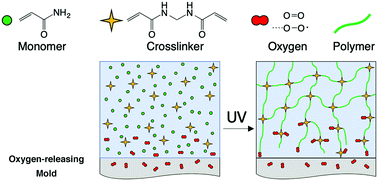Oxygen inhibition of free-radical polymerization is the dominant mechanism behind the “mold effect” on hydrogels†
Abstract
Hydrogel surfaces are of great importance in numerous applications ranging from cell-growth studies and hydrogel-patch adhesion to catheter coatings and contact lenses. A common method to control the structure and mechanical/tribological properties of hydrogel surfaces is by synthesizing them in various mold materials, whose influence has been widely ascribed to their hydrophobicity. In this work, we examine possible mechanisms for this “mold effect” on the surface of hydrogels during polymerization. Our results for polyacrylamide gels clearly rule out the effect of mold hydrophobicity as well as any thermal-gradient effects during synthesis. We show unequivocally that oxygen diffuses out of certain molding materials and into the reaction mixture, thereby inhibiting free-radical polymerization in the vicinity of the molding interface. Removal of oxygen from the system results in homogeneously cross-linked hydrogel surfaces, irrespective of the substrate material used. Moreover, by varying the amount of oxygen at the surface of the polymerizing solutions using a permeable membrane we are able to tailor the surface structures and mechanical properties of PAAm, PEGDA and HEMA hydrogels in a controlled manner.



 Please wait while we load your content...
Please wait while we load your content...